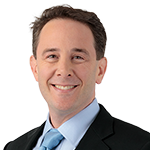Four questions: Why invest in healthcare now?
Portfolio Managers Andy Acker and Dan Lyons cover key investment questions about healthcare.
3 minute watch
Key takeaways:
- Healthcare is a traditionally defensive area of the market that can also boast significant growth opportunities.
- Over the past decade, the gap between the top- and bottom-performing healthcare stocks has been the widest of any sector due to risks such as high failure rates in drug development.
- Long term, the sector’s growth potential looks substantial, as medical breakthroughs lead to new and growing end markets.
IMPORTANT INFORMATION
Health care industries are subject to government regulation and reimbursement rates, as well as government approval of products and services, which could have a significant effect on price and availability, and can be significantly affected by rapid obsolescence and patent expirations.
Actively managed portfolios may fail to produce the intended results. No investment strategy can ensure a profit or eliminate the risk of loss.
1 IQVIA Institute, Global Trends in R&D 2023: Activity, Productivity, and Enablers. February 2023.
Question: How would you describe the healthcare sector?
Andy Acker: When you think about healthcare, it really is quite a diverse sector. And I think it’s important to keep in mind there are some stocks within healthcare that are highly defensive. And these could be large-cap pharmaceutical companies, medtech companies, HMOs. What makes these companies so defensive is that the demand for healthcare is fairly inelastic even during an economic slowdown. When we get sick, we need to go see a doctor.
On the other hand, you have so much innovation happening in the sector. And in fact, it’s like nothing we’ve ever seen before. This could be a record year for new product launches, and that’s really being driven especially by small- and mid-cap biotech companies. This is where two-thirds of the innovation comes from, and the new products that are in development are coming from these small companies that are often not well represented in the large healthcare indices.1
Question: How do rising costs impact the outlook for the sector?
Dan Lyons: Whenever we’ve seen these innovative therapies that Andy was talking about coming out, we’ve seen healthcare systems around the world figure out ways to pay for them. So, whenever you’re really changing the practice of medicine people are willing to pay for that.
Acker: Let’s think about obesity. Obesity has been a growing, really epidemic, not just in the United States, but around the world. And they cost much more to treat. When we think about heart disease, cancer, diabetes, liver disease, kidney disease – virtually every disease you could get is increased by being substantially overweight.
So now, we have new therapies that for the first time can give levels of weight loss that we’ve never seen before. So, we have therapies that are given once a week injectables, or once-daily orals that are in development, that are reaching 15% to 20% weight loss.
Just very recently, we’ve had data now called the SELECT study that showed for the first time that just losing weight alone is enough to drive an improvement in cardiovascular outcomes. So, we’ve seen a 20% reduction in heart attacks and strokes and cardiovascular death. That means we’re going to have substantial savings by using these drugs.
Question: How can investors reduce their downside risk in the sector?
Lyons: I think, oftentimes, benchmarks don’t adequately capture these great sources of innovation. And that’s what really creates the opportunity for investing in an actively managed fund within the sector. Because healthcare has the widest disparity between the winners and the losers, and if you’re just investing in a benchmark, you’re getting a lot of exposure to all those losers.
Question: What’s an example of healthcare’s growth potential?
Acker: If we think about surgery, robotic surgery, less than 10% of procedures today are done using the aid of a robot. And yet, with a robot you can be more precise than the human hand. You can improve outcomes. You can lower bleeding, lower pain. Basically, better in every way for the patient. And again, these are markets measured in the billions of dollars, still less than 10% penetrated. So, we see growth, not just for the next few years, but really for the next few decades. And that’s what gets us so excited in the healthcare sector.
These are the views of the author at the time of publication and may differ from the views of other individuals/teams at Janus Henderson Investors. References made to individual securities do not constitute a recommendation to buy, sell or hold any security, investment strategy or market sector, and should not be assumed to be profitable. Janus Henderson Investors, its affiliated advisor, or its employees, may have a position in the securities mentioned.
Past performance does not predict future returns. The value of an investment and the income from it can fall as well as rise and you may not get back the amount originally invested.
The information in this article does not qualify as an investment recommendation.
Marketing Communication.
Important information
Please read the following important information regarding funds related to this article.
- Shares of small and mid-size companies can be more volatile than shares of larger companies, and at times it may be difficult to value or to sell shares at desired times and prices, increasing the risk of losses.
- If a Fund has a high exposure to a particular country or geographical region it carries a higher level of risk than a Fund which is more broadly diversified.
- Shares/Units can lose value rapidly, and typically involve higher risks than bonds or money market instruments. The value of your investment may fall as a result.
- The Fund is focused towards particular industries or investment themes and may be heavily impacted by factors such as changes in government regulation, increased price competition, technological advancements and other adverse events.
- The Fund may use derivatives to help achieve its investment objective. This can result in leverage (higher levels of debt), which can magnify an investment outcome. Gains or losses to the Fund may therefore be greater than the cost of the derivative. Derivatives also introduce other risks, in particular, that a derivative counterparty may not meet its contractual obligations.
- If the Fund holds assets in currencies other than the base currency of the Fund, or you invest in a share/unit class of a different currency to the Fund (unless hedged, i.e. mitigated by taking an offsetting position in a related security), the value of your investment may be impacted by changes in exchange rates.
- Securities within the Fund could become hard to value or to sell at a desired time and price, especially in extreme market conditions when asset prices may be falling, increasing the risk of investment losses.
- The Fund could lose money if a counterparty with which the Fund trades becomes unwilling or unable to meet its obligations, or as a result of failure or delay in operational processes or the failure of a third party provider.
Specific risks
- Shares/Units can lose value rapidly, and typically involve higher risks than bonds or money market instruments. The value of your investment may fall as a result.
- Shares of small and mid-size companies can be more volatile than shares of larger companies, and at times it may be difficult to value or to sell shares at desired times and prices, increasing the risk of losses.
- If a Fund has a high exposure to a particular country or geographical region it carries a higher level of risk than a Fund which is more broadly diversified.
- The Fund is focused towards particular industries or investment themes and may be heavily impacted by factors such as changes in government regulation, increased price competition, technological advancements and other adverse events.
- The Fund may use derivatives to help achieve its investment objective. This can result in leverage (higher levels of debt), which can magnify an investment outcome. Gains or losses to the Fund may therefore be greater than the cost of the derivative. Derivatives also introduce other risks, in particular, that a derivative counterparty may not meet its contractual obligations.
- If the Fund holds assets in currencies other than the base currency of the Fund, or you invest in a share/unit class of a different currency to the Fund (unless hedged, i.e. mitigated by taking an offsetting position in a related security), the value of your investment may be impacted by changes in exchange rates.
- When the Fund, or a share/unit class, seeks to mitigate exchange rate movements of a currency relative to the base currency (hedge), the hedging strategy itself may positively or negatively impact the value of the Fund due to differences in short-term interest rates between the currencies.
- Securities within the Fund could become hard to value or to sell at a desired time and price, especially in extreme market conditions when asset prices may be falling, increasing the risk of investment losses.
- The Fund may incur a higher level of transaction costs as a result of investing in less actively traded or less developed markets compared to a fund that invests in more active/developed markets.
- The Fund could lose money if a counterparty with which the Fund trades becomes unwilling or unable to meet its obligations, or as a result of failure or delay in operational processes or the failure of a third party provider.




